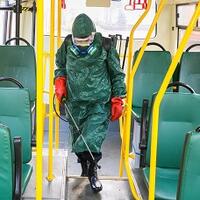|
By most accounts, the Zelensky administration’s strong response to the spread of the novel coronavirus was taken early and swiftly. Mass events were banned and schools were closed for three weeks on March 12. Transportation, including airlines, interregional trains, and city metros were shut down on March 17. At the same time, restaurants, bars, gyms, and shopping centers were also closed. Only outlets that sold food products, fuel, hygiene products, medicine, and other medical products were allowed to stay open. The government had to evacuate some 35,000 Ukrainians from abroad following the shutdown of the border. |
As of Tuesday, June 9,
27,856 confirmed cases; 810 deaths; and (per Kyiv Post) |
The earliest cases of COVID-19 appeared in the Chernivtsi region in southwestern Ukraine and the Zhytomyr region in central Ukraine, following many people’s return from other countries in Europe, especially Italy. Following the rapid spread of the disease throughout March, the government imposed further distancing measures, including a ban on the use of playgrounds and outdoor sports equipment. An April 1 poll showed that over 80 percent of the population supported the ban on mass events, and over 70 percent supported limiting transportation in certain cities. Most respondents felt that the government’s preparations were adequate, while only 6 percent felt the authorities were overreacting.

Yet the government has not necessarily instilled confidence during the crisis. Former Minister of Health, the 64-year-old Illia Yemets, referred to people over 65 as “corpses” because of their greater susceptibility to the novel coronavirus. However, on March 27, Chief Sanitary Doctor Viktor Lyashko reported the following statistics: half the people infected were between the ages of 18 and 49; people 50-65 years old made up 30 percent of cases, and people older than 65 made up just 6 percent of cases. Given Yemets’ insensitive comments and misrepresentation of data, Parliament drafted a resolution to remove Yemets, and he was ultimately fired after 26 days in his position and replaced by Maksym Stepanov on March 30.
One major point of concern was Ukrainian hospitals’ capacity to care for a surge in cases of COVID-19, and, relatedly, the acquisition and distribution of protective medical equipment. On March 11, the government banned the export of medical equipment, which Ukraine had previously been shipping abroad, especially to Spain, Italy, and China. Alcohol and textile companies began manufacturing sanitizers and protective medical equipment to respond to domestic shortages. Yet healthcare professionals made up nearly one-fifth of all coronavirus cases in Ukraine; many have not been able to access effective protective equipment. Hospitals lack the facilities for large numbers of patients, and many have few or very old ventilators. In mid-April, the Ministry of Health stated that 242 hospitals in Ukraine were taking COVID-19 patients, and they were equipped with 2,042 lung ventilators and had 1,371 vacant intensive care beds. But each facility had a different capacity for sustained treatment as well as a limited number of staff to care for patients.
A scandal has broken out surrounding the procurement of necessary medical equipment to prepare hospitals for this and future health crises. Medical Procurement of Ukraine (MPU) is a new state body, established in 2018 with the intent of fighting corruption in the procurement of medical equipment. Its head, Arsen Zhumadilov, claimed that the government overruled the MPU’s choice in awarding a contract to a company delivering hospital protective suits. Because of the high rate of infection among medical workers, the suits were an important part of keeping Ukraine’s infection rate down. MPU awarded the contract to a domestic company, Textil-Kontakt, but the government cancelled that contract in favor of another company, Meddiv. The Minister of Health claimed that Textil’s suits offered no more protection than “a house painter’s overalls,” but in reality, both companies’ suits offered the same protection. Meddiv’s suits, imported from China, cost almost twice as much (489 UAH) as those from Textil (245 UAH), and, additionally, the imports were delayed by weeks. Only 29,000 of the promised 71,347 suits arrived in Ukraine by May 19, which was nearly as many as Textil had made to fulfill the order when its contract was cancelled. MP Oleksandra Ustinova (Holos Party) published documents revealing the deal, and the Anti-Corruption Action Center is investigating potential corruption in the procurement contracts.

The status of the Ukrainian military and residents of the occupied Donbas are important considerations for governing the pandemic. Following the death of one woman working at a military base in the western city of Ivano-Frankivsk, the active duty soldiers in the Donbas implemented further preventative measures, such as checking temperatures and regular disinfection of military vehicles and installations. A Ukrainian military police serviceperson was the first confirmed COVID-19 case in the war zone in the Donbas on May 26; at that time, the entire Ukrainian Armed Forces had confirmed only 60 cases among military personnel.
The Ukrainian government shut down movement along the line of contact in the Donbas on March 28, but many people are now stuck on one side or the other. People have been stranded at checkpoints and often lack the means to find shelter. In typical circumstances, the border is quite porous, with the United Nations data showing 1,067,899 crossings in January 2020 alone. In the context of a nation-wide lack of testing, even government-occupied parts of Donetsk and Luhansk have an especially low number of cases. On the non-government-controlled side, theoretically governed by Russia’s coronavirus policy, numbers are also suspiciously low, in line with general, widely criticized Kremlin reporting. Ukraine’s ombudsman to the occupied territories, Lyudmyla Denisova, said that 150 people in occupied Donbas were hospitalized with suspected pneumonia, but there was no testing for COVID-19 in those hospitals or in any of the Russian-occupied territories.
Of course, the economic impact of the virus on Ukraine is a major point of concern. In March, former Minister of Economy Tymofiy Mylovanov estimated that half a million Ukrainians could lose their jobs. In early May, Ukraine had registered 456,800 unemployment claims, 48 percent more than in 2019. In response, the government allocated an extra $85.3 million to unemployment benefits. In mid-April, the government amended the 2020 budget to include a $2.4 million fund to address the pandemic, including directing additional funding to the National Health Service and pension funds. Yet, according to Kyiv School of Economics researchers, Ukraine could lose up to $53.5 billion in gross domestic product because of the economic consequences of the pandemic and quarantine. This figure represents the worst-case scenario, in which the disease does not slow its spread over the summer of 2020. In May, analysts predicted that Ukraine’s GDP would shrink about 5 percent in 2020. The lack of remittances from Ukrainians working abroad could also have a major impact on Ukraine’s economy. In 2019, remittances were nearly 10 percent of Ukraine’s GDP, at $12.9 billion. However, the International Monetary Fund (IMF) has shifted talks with Ukrainian representatives to focus on an 18-month aid package that will directly manage coronavirus recovery efforts. Additionally, the European Union has proposed allocating a 1.2 billion euro loan to Ukraine, as part of a bigger package of aid to countries including Georgia, Moldova, Tunisia, and Kosovo.
The best long-term solution, many have advocated, is better and more widespread testing. The Ministry of Health is planning mass antibody testing, which was announced as beginning in late May; no data is yet available from this mass testing. Throughout the crisis, Ukraine has been criticized for its lack of widespread testing or clear testing policy. Through April, only people who showed symptoms and sought medical help were tested, or people diagnosed with pneumonia, people returning to Ukraine from abroad, and people who were in contact with confirmed patients. Additionally, in order to be cleared as “recovered,” patients are required to receive two negative tests; the number of tests represented in official statistics does not differentiate patients who were tested more than once.
Ukraine has a long road ahead to recover from the pandemic, even as restaurants and transportation begin to open. The assessment of the Zelensky government’s response to the COVID-19 crisis should not be rushed and should consider the long-term impact on the Ukrainian population’s well-being.
 Emily Channell-Justice is the Director of the Temerty Contemporary Ukraine Program at the Harvard Ukrainian Research Institute. She received her PhD in sociocultural anthropology from The Graduate Center, City University of New York, in 2016. Her research focuses on political participation and social movements in contemporary Ukraine, where she has done ethnographic fieldwork since 2012. She has received grants from Fulbright IIE and American Councils Title VIII Research Scholar Program, and she has taught in anthropology and international studies departments at Miami University (Ohio) and John Jay College of Criminal Justice (CUNY).
Emily Channell-Justice is the Director of the Temerty Contemporary Ukraine Program at the Harvard Ukrainian Research Institute. She received her PhD in sociocultural anthropology from The Graduate Center, City University of New York, in 2016. Her research focuses on political participation and social movements in contemporary Ukraine, where she has done ethnographic fieldwork since 2012. She has received grants from Fulbright IIE and American Councils Title VIII Research Scholar Program, and she has taught in anthropology and international studies departments at Miami University (Ohio) and John Jay College of Criminal Justice (CUNY).
 Ukraine began its first stages of post-quarantine opening over the week of May 25, 2020. As the country continues to ease restrictions, we can begin to
Ukraine began its first stages of post-quarantine opening over the week of May 25, 2020. As the country continues to ease restrictions, we can begin to